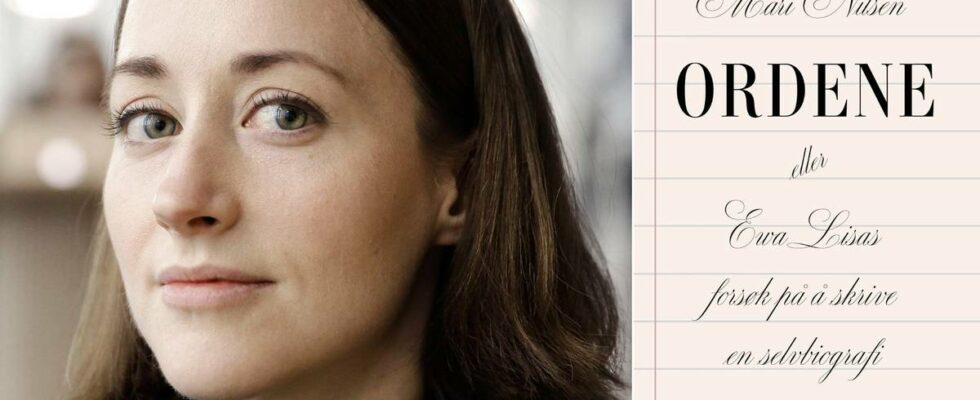There is someone who speaks very loudly in “The words, or Ewa Lisa’s attempt to write an autobiography”. The letters stand out from the paper. At first I am embarrassed. You don’t stand around and cackle in a completely quiet room. Then I listen extra. What is shouted must be important, I think, or feel right to the person shouting. SMALL: This small book is a genre of its own. Photo: news The book has the category story. The text resembles a poem, or a novel in poem form – and I already notice that the genre talk bores me. What I appreciate about Mari Nilsen’s debut book is precisely that it doesn’t immediately resemble anything. This is Ewa Lisa’s speech. Through it, she emerges as the slightly strange character she is. I am glad that she has been allowed to speak – even if what she says is horrifying. The body you do not decide on the Chapter titles gives expectations for the content of this narrow book. The first chapter is called “About me”, the second chapter “Childhood and adolescence”, the third chapter “My near and dear ones”, and so on. But it is not that simple. Ewa Lisa derails. In “About me” we do not get any basic facts. Instead, Ewa Lisa goes straight to her love life – which obviously says something about her, but it’s up to the reader to form an impression. The second chapter takes time before it reflects on the title. For example, it’s about the swollen hands Ewa Lisa has inherited from her mother, the “boxing gloves” she soaks in cold water and drinks to forget. The mother got her hands from the grandmother – they were so ugly that the grandfather left. It is here that the main theme prys free from the lines: the body associated with inevitable misfortune. BRAKDEBUT: Mari Nilsen has written a rock-solid debut that stands out in Norwegian contemporary literature, says news’s critic. Photo: Anna-Julia Granberg / Blunderbuss In addition to the hands, Ewa Lisa talks a lot about someone inserting themselves or an object into either her or someone else’s ass. A glass bottle, shower head, candlestick and a whole hand are pressed into a body. The gender theme is implicit: Ewa Lisa’s hands are a woman’s legacy, like the open body. As a girl, sooner or later you are forced to deal with the fact that you have an opening into your internal organs, which is accessible to others. Even with the legs pressed tightly together, someone can get inside. The butt is a less natural place to introduce something, because things come out there. In the book, when things are pushed into people’s butts, this sense of horror is recreated as that of the realization that sex is often about letting someone penetrate you, literally invading you. To therefore want to escape from the becoming female body is a sadly familiar motive. In the letter from 14-year-old Ewa Lisa, it says: Struggling with setting boundaries It is with our hands that we grasp, bring something closer or push it away. The hands are the strongest symbol of the will. I interpret the fact that Ewa Lisa’s hands are constantly swelling as a damaged self-determination. That she has difficulty setting boundaries. Not just words, words, words Already on the first page, the humor of Ewa Lisa’s slightly confusing personality is shown: Followed by seven “WORDS” scattered across the page like ashes. WORDS: Apart from the chapter titles, all words in the book are written in capital letters. Photo: news The statement punctures the premise of the book. How can she, who writes words that almost beg to be read, reject the words herself? Writing offers several contradictions: You may want to get closer to what you are writing about, to really do what was previously only in your heart. At the same time, one fears the reducing effect of drawing down, that the narrative and feelings take on a rigid and artificial form. Is the desire to materialize oneself greater with such a chaotic personality as Ewa Lisa’s? The chapter titles in loop script point to the physical script, as do the instances of crossed-out words. Ewa Lisa writes that she doesn’t like the pen she writes with, and that she prefers to write at home, where she can mess up more than in the cafe. SMALL GRIPS: Loop writing and strikeouts help the reader to see the physical writing process. Photo: news The text comments on its own creation – we imagine the physical writing on the physical paper. But more importantly: We imagine Ewa Lisa unfolding in the present, that she moves and has feelings. It is vulnerable to shout, then everyone knows that you mean what you say! The book is not just words, words, words. Ewa Lisa is not just a funny character. She really holds something. The best reading Ewa Lisa is impulsive, capricious and hot-tempered with a naked despair and a wisdom that lurks beneath the apparent stupidity. Like a child who has not understood the rules, she is a little too honest and does not start where she should. Her writing is bouncy, rhythmic and full of antics. Thanks! It is when a text carries off like this, every sign and choice of words coated with personality, that I enjoy reading. Then it can be about anything for me. I can easily imagine how this book could be made more conventionally (and commercially) recognizable. Fortunately, apparently little reining has been done. Norwegian contemporary literature is too rare. It is touching that a debutante has been allowed to frolic in this way. news reviews Photo: Tiden Norsk Forlag Title: “The words, or Ewa Lisa’s attempt to write an autobiography” Author: Mari Nilsen Genre: Novel Number of pages: 82 Published: 2024 Publisher: Tiden Norsk Forlag Published 09.07.2024, at 21.38
ttn-69
“The words, or Ewa Lisa’s attempt to write an autobiography” by Mari Nilsen – Reviews and recommendations

